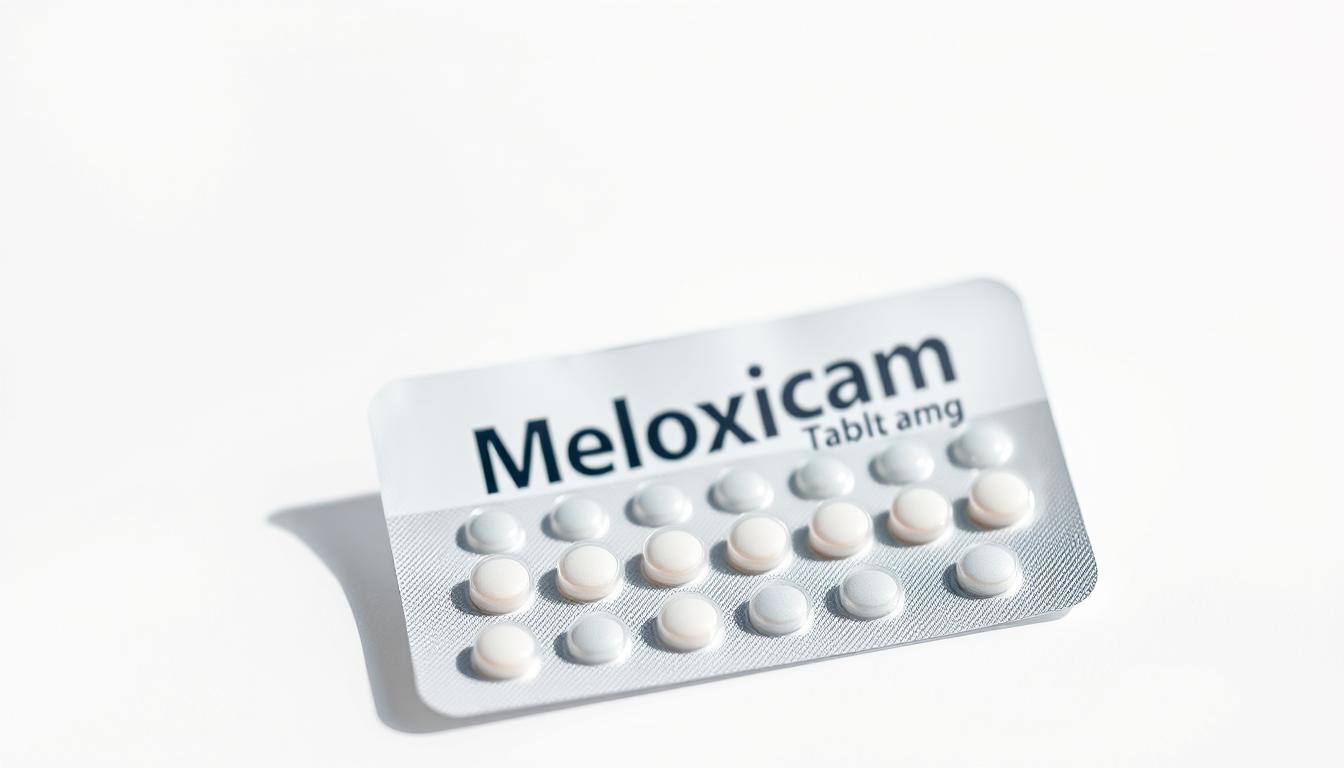Did you know that about 54 million adults in the United States have arthritis? This number shows how important it is to find good pain relief. Meloxicam is a key drug for this, helping with pain and swelling.
This article will cover Meloxicam’s key points. We’ll talk about how to use it, its benefits, and possible side effects. If you’re looking for pain relief or want to know more about treating arthritis with Meloxicam, this guide is for you.
Key Takeaways
- Meloxicam is a widely used NSAID that provides pain relief for arthritis and other inflammatory conditions.
- Understanding Meloxicam usage can help you manage your symptoms effectively.
- Consultation with a healthcare provider is essential for safe Meloxicam administration.
- Awareness of potential side effects can aid in monitoring your health while using this medication.
- Meloxicam offers specific advantages over other NSAIDs in chronic pain management.
- Regular follow-ups are important to evaluate the effectiveness and safety of Meloxicam therapy.
What Is Meloxicam?
Meloxicam is a common medication known as a nonsteroidal anti-inflammatory drug (NSAID). You might ask, what is Meloxicam? It mainly helps with pain and swelling, like in osteoarthritis and rheumatoid arthritis. It comes in tablets and liquid, known for its effectiveness and safety.
Overview of the Medication
Meloxicam is a good option for chronic pain. It works by stopping certain enzymes, which reduces inflammation and pain. Its special formula makes it last longer, which doctors often prefer.
How It Works
Knowing how Meloxicam works helps you see its benefits. It blocks enzymes in your body, stopping the creation of pain-causing substances. This not only eases pain but also reduces swelling and improves movement.
Uses of Meloxicam
Meloxicam is used for many pain and inflammatory conditions. Knowing its Meloxicam uses helps you talk better with doctors. It also improves your pain management plan.
Pain Relief
Many people use Meloxicam for Meloxicam pain relief. It’s good at easing pain from sudden issues. This includes pain after surgery or injuries. It’s key for managing short-term pain.
Inflammatory Conditions
Meloxicam is great for inflammatory conditions. It stops substances that cause pain and swelling. This makes it a top choice for managing swelling and discomfort.
Osteoarthritis and Rheumatoid Arthritis
A lot of Meloxicam is used for Meloxicam arthritis. It helps with stiffness and swelling in arthritis. This lets patients move better and enjoy daily activities more.
Dosage and Administration
Knowing the right Meloxicam dosage is key for good treatment. Adults usually take 7.5 mg to 15 mg once a day. Your health needs might change this, so talk to your doctor for the best plan.
Recommended Dosage for Adults
Adults often start with 7.5 mg daily. If your pain is worse, your doctor might up it to 15 mg. It’s important to take Meloxicam at the same time every day. This keeps the medicine working well in your body.
Taking Meloxicam Safely
Sticking to your doctor’s dosage is important. Don’t take more without asking first. Watch for side effects and tell your doctor about other medicines you’re taking. This helps avoid bad reactions.
Missed Dose Instructions
If you miss a dose, take it as soon as you remember. But if it’s almost time for your next dose, just skip the missed one. Never take two doses together. This keeps you safe and on track with your treatment.
Potential Side Effects
It’s important to know about Meloxicam side effects before taking it. Many people do well on Meloxicam, but knowing about side effects helps manage health better.
Common Side Effects
Common side effects of Meloxicam include:
- Nausea
- Diarrhea
- Headaches
- Dizziness
These side effects can vary in how bad they are. They can often be helped with simple home remedies or by adjusting the dosage. But, it’s key to watch out for them.
Serious Side Effects
Some serious side effects of Meloxicam can be dangerous. These include:
| Serious Side Effect | Description |
|---|---|
| Gastrointestinal Bleeding | Symptoms may include vomit that looks like coffee grounds or black stools. |
| Heart Issues | Chest pain or shortness of breath may indicate severe cardiovascular complications. |
| Liver Complications | Signs include yellowing of the skin or eyes, dark urine, or abdominal pain. |
| Severe Allergic Reactions | Symptoms can include hives, difficulty breathing, and swelling of the face or throat. |
It’s vital to watch for these serious side effects. Quick medical help can save lives.
When to Contact Your Doctor
If you have serious side effects or if common side effects get worse, call your doctor right away. Talking often with your doctor helps catch and fix problems quickly. This keeps your health safe and sound.
Drug Interactions
It’s important to know about Meloxicam interactions to stay safe. Different things can change how Meloxicam works in your body. Knowing about medications and food that can affect Meloxicam helps avoid bad side effects and makes treatment better.
Medications That May Affect Meloxicam
Some medicines can change how well Meloxicam works or increase its risks. For example:
- Blood thinners like warfarin can make bleeding more likely.
- Other NSAIDs, such as ibuprofen and naproxen, can also interact.
- Certain antidepressants might not work well with Meloxicam.
Food and Alcohol Interactions
What you eat can affect Meloxicam’s performance. Drinking alcohol while taking Meloxicam can make stomach problems worse. Try to drink less alcohol while you’re on this treatment.
Herbal Supplements Considerations
Herbal supplements can also impact Meloxicam. They might change how well Meloxicam works or increase side effects. Always talk to your doctor about any herbal products you’re taking.
Precautions and Warnings
Before starting Meloxicam, it’s key to know the specific precautions and warnings. Certain people need to be extra careful. Some health conditions can change how Meloxicam works in the body.
Individuals Who Should Avoid Meloxicam
If you have heart disease, severe liver or kidney problems, or stomach issues, Meloxicam might not be right for you. These precautions are important to avoid serious issues. Always talk to your doctor to find the safest option for you.
Pregnancy and Breastfeeding Considerations
Meloxicam can be risky during pregnancy, mainly after 20 weeks, as it may harm the fetus. If you’re pregnant or planning to get pregnant, talk to your doctor about the risks. Breastfeeding moms should also be careful, as Meloxicam can get into breast milk. Knowing these warnings helps you make better choices for your health and your baby’s.
Risks for Older Adults
Older adults face higher risks with medications like Meloxicam. Heart problems and stomach issues are more common with age. It’s crucial for this group to follow Meloxicam precautions. Regular check-ups and open talks with doctors can help manage side effects.
Benefits of Using Meloxicam
Learning about Meloxicam’s benefits can help you manage your pain better. This medicine helps reduce pain and swelling, which is great for people with arthritis. Here are some key benefits you might see.
Effectiveness for Pain Management
Many people find Meloxicam helps a lot with pain. It works by reducing inflammation, which helps keep the pain away for longer. This makes it a good choice for those with chronic pain from arthritis and other inflammatory conditions.
Advantages Over Other NSAIDs
Meloxicam has fewer side effects than some other pain medicines. It also needs to be taken less often, which makes it easier to stick to. This can lead to better pain control and more happiness with treatment.
Long-Term Use Considerations
Using Meloxicam for a long time can be good, but you need to watch out. It’s important to see your doctor regularly to check for any problems. Knowing this can help keep Meloxicam safe for managing ongoing pain.
Monitoring and Follow-Up Care
When you start taking Meloxicam, it’s key to keep up with monitoring and follow-up care. Regular visits to your doctor help them see how well the medicine is working. They’ll check your blood and how you’re feeling to keep you safe and effective.
Importance of Regular Check-Ups
Regular check-ups are crucial for your treatment. These visits let your doctor:
- Check if Meloxicam is helping your symptoms
- Watch for any bad side effects
- Change your dosage if needed
By keeping up with these appointments, you can spot problems early. This leads to better health for you.
Signs That Require Medical Attention
While on Meloxicam, watch out for any odd symptoms. Tell your doctor right away if you notice:
- Severe stomach pain
- Long-lasting headaches or dizziness
- Signs of an allergic reaction, like rash, itching, or swelling
Spotting these signs early is key for good follow-up care. Your health is important, and acting fast can help a lot.
Alternatives to Meloxicam

If you’re looking for alternatives to Meloxicam, there are many options. You can try over-the-counter pain relief or non-pharmaceutical therapies. These can help manage pain and inflammation without prescription drugs.
Over-the-Counter Options
For over-the-counter pain relief, ibuprofen and naproxen are good choices. These are NSAIDs that help with mild to moderate pain. They reduce inflammation, making them great for everyday aches.
Non-Pharmaceutical Therapies
There are also non-pharmaceutical therapies for pain management. Some include:
- Physical therapy: A program to reduce pain and improve mobility.
- Acupuncture: An ancient method that may relieve pain by targeting specific body points.
- Lifestyle changes: Regular exercise, healthy eating, and mindfulness can help lower pain levels.
When to Consider Alternatives
Talking to a healthcare provider is key to finding the right solution. If Meloxicam causes side effects or doesn’t work, try over-the-counter options or non-pharmaceutical therapies. This way, you get the best care for your pain management needs.
Conclusion
In this Meloxicam recap, you’ve learned about its uses. It helps manage pain and treat conditions like osteoarthritis and rheumatoid arthritis. You also know about possible side effects and how to avoid drug interactions.
Remember, Meloxicam is effective but needs careful use. Always talk to your healthcare provider about any questions or concerns. This is important for your health and pain management.
By working with your healthcare provider, you can make the best choices for your health. This way, you can get the most out of your treatment plan.



